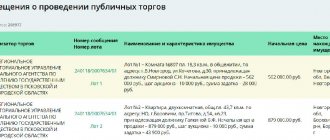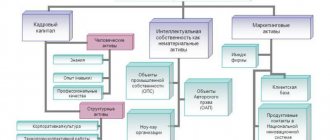Uncertainty of the concept of “real estate”.
Current legislation
By virtue of paragraph 1 of Art. 374 of the Tax Code of the Russian Federation, objects of taxation for Russian organizations are recognized as real estate (including property transferred for temporary possession, use, disposal, trust management, contributed to a joint activity or received under a concession agreement), recorded on the organization’s balance sheet as fixed assets in the manner established for accounting, if the tax base for such property is determined in accordance with paragraph 1 of Art. 375 of the Tax Code of the Russian Federation (as the average annual value of property), unless otherwise provided by Art. 378 and 378.1 Tax Code of the Russian Federation .
The rules for the formation in accounting of information about the organization’s fixed assets are approved by PBU 6/01 “Fixed Assets” , according to which maintaining accounting records of assets depending on their classification as movable and immovable property is not provided. We also note that there is no definition of these concepts in accounting.
For your information:
From 01/01/2022, PBU 6/01 will no longer be in force due to the beginning of mandatory application of FSBU 6/2020 “Fixed Assets” , approved by Order of the Ministry of Finance of Russia dated 09/17/2020 No. 204n . In this case, the organization may decide to apply this standard as early as 2021.
Based on Art. 130 and 131 of the Civil Code of the Russian Federation, real estate includes land plots, buildings, structures, unfinished construction projects, watercraft and aircraft and other objects subject to state registration or state accounting.
The current legislation does not contain a definition of movable property. According to paragraph 2 of Art. 130 of the Tax Code of the Russian Federation , things not related to real estate, including money and securities, are recognized as movable property. Registration of rights to movable things is not required, except in cases specified in the law.
Article 130 of the Civil Code of the Russian Federation. Immovable and movable things (current edition)
1. One of the most important classifications of things is the division of things into movable and immovable. The Civil Code of the Russian Federation in the new edition of the commented article also provides for such a division of things. Thus, according to the commented article, all things are divided into immovable and movable. The difference in the legal regime of movable and immovable things is that registration of the transfer of rights to the latter requires state registration with the relevant government bodies.
A distinctive feature of real estate is its inextricable connection with the land (while the land plots themselves are also considered as real estate), which, in turn, implies its significant value. Without connection with land plots, immovable property loses its usual purpose and, accordingly, decreases in price. Thus, trees grown in special nurseries or houses intended for demolition are not considered real estate.
It should be noted that in paragraph 1 of the commented article of the Civil Code, in addition to the term “immovable things”, the term “real estate” is also used. It seems that in this case we are talking about an error that is repeated again in the Civil Code. As you know, the concept of “property” is a broader concept compared to the concept of “things”, since it includes, in addition to things, also property rights. This circumstance gives grounds for some lawyers to assert that “the concept of real estate, used in the commented article, must be understood as real estate, which includes both things and property rights to these things.” This is explained as follows. The use of things by persons who are not the owners is possible only by granting them the corresponding property rights by the owner. And therefore, the objects of civil rights to use other people’s things are not things as such, but only the rights to use them.
———————————
Civil law / Ed. V.P. Mozolina. M., 2003. Part 1. P. 212.
According to paragraph 1 of Art. 130 of the Civil Code, all real estate objects can be divided into three groups:
1) real estate objects that are immovable by nature (land, subsoil, etc.);
2) objects that are firmly connected to the ground and their movement entails disproportionate damage to their purpose (buildings, structures, etc.);
3) objects that, by their physical nature, are movable, but the legislator classified them as real estate (ships, aircraft, etc.), despite the fact that the question of the legality of classifying the latter as real estate was raised a long time ago, no changes have been made in the commented article of the Civil Code.
The legislator left the presence of a strong connection with the land as a fundamental feature of real estate. However, the application of this feature in practice at present can cause significant difficulties. It should be borne in mind that many buildings and structures can, in principle, be moved from one site to another, while maintaining their integrity and purpose (however, they can only qualify as real estate if an inextricable physical connection with the land arises anew) . For example, wooden houses (log houses) in rural areas are quite often moved from one place to another in disassembled form. It should be noted that modern technologies make it possible to move any building or structure from place to place without causing serious damage.
As before, the criteria for a strong connection with the land and disproportionate damage are not established by law. This will cause certain difficulties, since, based on the formal interpretation of these criteria, objects such as fences, benches, etc. can be classified as real estate. Accordingly, the rights to them must be registered, which may cause technical difficulties.
Such types of real estate as residential and non-residential premises are distinguished as independent objects of civil rights, but a basic, legal definition of the concept of premises is not given in the Civil Code.
In current legal acts, the legal definition of premises is contained in the following legal acts. Thus, Federal Law of December 30, 2009 N 384-FZ “Technical Regulations on the Safety of Buildings and Structures” defines a premises as a part of the volume of a building or structure that has a specific purpose and is limited by building structures (Article 2). According to Part 2, Clause 6, Art. 12 Federal Law “On state registration of rights to real estate and transactions with it” premises are objects that are part of buildings and structures.
Special types of real estate, both under the previous and new legislation, are ships, aircraft, inland navigation vessels, and space objects. Sometimes in relation to them such a concept as conditional real estate is used, or, as it is also called, real estate by force of law.
———————————
Erdelevsky A.M. State registration of mortgage // Law. 2002. N 10. P. 40.
The concept and types of the mentioned vehicles considered as real estate are disclosed in the relevant transport charters and codes. Transport charters and codes also indicate for which vehicles rights are registered and establish the procedure for their registration.
For the first time, parts of buildings or structures intended to accommodate vehicles (car spaces) are considered as immovable things, if the boundaries of such premises, parts of buildings or structures are described in the manner established by the legislation on state cadastral registration.
2. Paragraph 2 of the commented article states that movable things include things that are not related to real estate, including money and securities. Thus, there is no legal definition of movable property. However, if movable things are included as an integral part of a property complex (for example, an enterprise) related to real estate, then they automatically lose the quality of movable property for the period of such inclusion.
As a general rule, registration of rights to movable things is not required, but otherwise may be provided by law.
Comment source:
“CIVIL CODE OF THE RUSSIAN FEDERATION. PART ONE. ARTICLE-BY-ARTICLE COMMENT"
S.P. Grishaev, T.V. Bogacheva, Yu.P. Sweet, 2019
Canceled letter from the Federal Tax Service.
The laconicism of the legislative wording does not add clarity to the issue of separating real estate from movable property, which raises questions for taxpayers. And regulatory authorities are trying to answer them. Thus, in February 2021, the Federal Tax Service sent its employees administering the taxation of property of organizations Letter No. BS-4-21/ [email protected] , in which it gave recommendations on the distinction between movable and immovable property for tax purposes. These recommendations were based on Letter No. D23i-4183 of the Ministry of Economic Development of Russia dated February 12, 2020. But not even 10 days had passed since the letter was withdrawn ( Letter of the Federal Tax Service of Russia dated February 25, 2020 No. BS-4-21/ [email protected] ).
Accounting for movable property
IMPORTANT! The lease agreement for movable and immovable property from ConsultantPlus is available here
From the above, it is clear that movable property, as civil law understands it, will be reflected in different accounts in accounting.
Account 01 and those corresponding to it may reflect the following movable property related to fixed assets:
- machines, equipment;
- office fixtures;
- transport;
- inventory;
- working and productive livestock;
- other types of OS.
The criteria for accounting for such movable property are defined by PBU-6:
- period of use over 12 months;
- subsequent resale is not initially planned;
- in the future the object will bring income to the company;
- its cost is from 40 thousand rubles.
BU wiring:
- Dt 08 Kt 60 (76, 10, 70) – an object of movable property (for example, a car) was acquired and the acquisition costs are reflected.
- Dt 01 Kt 08 – the initial cost (PV) of the asset is fixed.
The specified movable property is depreciated in accounting (in the following ways: reducing balance, linear, proportional to the volume of production, by the sum of the numbers of years of useful life).
There are only two methods of depreciation in NU: linear and nonlinear. As a rule, in order to bring accounting as close as possible and not make unnecessary entries, the linear method is used in both cases.
Formula for monthly depreciation: Depreciation = PS / useful life. use. Accrual posting: Dt 20 (20, 23, 26, 29, 44 and other “cost” accounts) Kt 02.
Analytical accounting for account 01 should take into account the division of property located on this account into movable and immovable. On account 10, in the context of subaccounts, another type of assets is taken into account, classified by the Civil Code of the Russian Federation as movable property: inventories, materials (raw materials, purchased semi-finished products, components, containers, spare parts, etc.) - all goods and materials that cannot be classified as main in accounting means.
Note that in NU the cost of fixed assets “starts” from 100 thousand rubles, and therefore temporary differences are formed in accounting. To account for the diversity of this group of movable property, subaccounts are widely used. For example, containers are taken into account on account 4, fuel – 3.
BU postings: Dt 10 Kt 60, 76, 20, 23, etc. - receipt of materials, depending on the source of receipt. Sometimes an interim account 15 “Procurement and receipt of inventory items” is used: Dt 10 Kt 15. Dt 08 Kt 10 – used inventory items in construction. Dt 20, 26, 28, 91, 44, 94 Kt 10 - transferred to production, for maintenance, used to correct defects, sold, written off as a shortage of goods and materials.
In addition, the civil code defines movable property as funds accounted for in active accounts 50 and 51 using standard transactions. Receipt: Dt 50, 51 Kt 60, 62, 66, 67, etc. – receipt (receipt) to the cash desk (to the current account) from various sources. 50, 51 are credited for expenses, the debit indicates where the funds went. Money can also be transferred to the current account from the cash register and back, for example: Dt 50 Kt 51.
Securities (Article 130 of the Civil Code, clause 2) are taken into account in the accounting system depending on their type and transactions. Account 58 is used as standard, and other accounting accounts are used less frequently.
VU wiring (example):
- Dt 58 Kt 51 – purchased by the Central Bank of another company.
- Dt 91 Kt 58 – sold to Central Bank.
- Dt 76 Kt 51 – bond paid.
- Dt 76 Kt 91 - income on it is recorded, etc.
Intangible assets (trademarks, software, inventions) are also classified as movable property of the company, despite the fact that they do not have a physical form. The characteristics of intangible assets are otherwise the same as those specified for operating systems; for example, they must be used for more than a year in the organization.
The postings through them, as in the previous case, are varied. Correspondence depends on the method of receipt of intangible assets, the method of its disposal.
VU wiring (example):
- Dt 08 Kt 60, 76, 66, etc. – paid to suppliers of intangible assets, duties, interest on loans, etc., were paid in connection with the acquisition of intangible assets.
- Dt 08 Kt 70, 69, 71, etc. – NMA was created in the organization.
- Dt 04 Kt 08 – registered with intangible assets.
- Dt 20, 26, etc. Kt 05 – depreciation of intangible assets.
- Dt 91 Kt 04 – asset sold, residual value reflected.
- Dt 05 Kt 04 – depreciation of retired intangible assets is written off.
Explanations from the Ministry of Finance.
A comprehensive solution to the issue. Then representatives of the Ministry of Finance issued Letter No. 03-05-05-01/34065 dated April 27, 2020 , in which they identified a number of issues related to the legal status of real estate, including the need to establish clarity regarding the characteristics of real estate objects. It was noted that a comprehensive solution to these issues is provided for by draft federal laws developed and submitted by the Ministry of Economic Development to the Government of the Russian Federation on October 17, 2018, which plan amendments to both the Civil Code of the Russian Federation and other laws in terms of improving legislation on real estate. But at the time of preparation of this material, these amendments have not been adopted.
Financiers noted: clarification in the legislation of the concept of immovable things primarily pursues the goal of civil law classification of things and is aimed at establishing a special procedure for the emergence and transfer of rights to real estate as property that, as a rule, has significant value, as well as additional protection of the rights of the owner of this property .
At the same time, the bills do not change the approaches to the procedure for imposing property taxes on organizations. However, the fact that currently individual objects, due to insufficient clarity of legal norms, can be recognized as real estate, in fact, not being such, confirms the need for the amendments proposed by the bills, which will avoid inaccuracies, including those allowed when assessing property with the property tax of organizations.
The question of whether an object is real estate is currently being resolved based on the Civil Code of the Russian Federation and the regulatory legal acts adopted in accordance with it, as well as taking into account the Civil Code of the Russian Federation at the stage of developing project documentation and obtaining permits.
Construction permit. At the end of 2021, the Ministry of Finance will issue two letters ( dated 11/09/2020 No. 03-05-05-01/97143 , dated 12/09/2020 No. 03-05-05-01/107458 ) on the topic under consideration, which provide the following explanations.
According to Art. 1 of the Civil Code of the Russian Federation, a capital construction facility means a building, structure, structure, objects whose construction has not been completed, with the exception of non-capital buildings, structures and inseparable improvements to a land plot (paving, covering, etc.). To create capital construction projects, it is necessary to prepare design documentation, obtain permits for construction and for putting the facility into operation ( Articles 48 , 48.1 , 49 , 51 , 55 of the Civil Code of the Russian Federation ). In connection with the above, the question of whether an object is real estate is decided at the stage of developing project documentation and obtaining permits. Financiers refer to the existing judicial practice on this issue:
– Ruling of the Supreme Court of the Russian Federation dated December 22, 2015 No. A27-18141/2014 in case No. 304-ES15-11476;
– clause 38 of the Resolution of the Plenum of the Armed Forces of the Russian Federation dated June 23, 2015 No. 25;
– Review of judicial practice of the Supreme Court of the Russian Federation No. 1 (2016) , approved by the Presidium of the Supreme Court of the Russian Federation on April 13, 2016.
Following the destiny of the main thing. In addition, representatives of the Ministry of Finance focus on another important issue: they are trying to classify movable property (machinery and equipment, land vehicles, industrial and household equipment) as real estate. Their logic is as follows.
According to Art. 135 of the Civil Code of the Russian Federation , as a general rule, a thing intended to serve another, main thing and connected with it by a common purpose (accessory) follows the fate of the main thing.
According to Rosreestr ( Letter No. 11-9273-AB/20 dated October 20, 2020 ), equipment that is inextricably linked physically or technologically with a capital structure, building or land plot, from the moment of joining the relevant real estate becomes its integral part, and this equipment cannot be considered as an independent property. Article 2 of the Federal Law of December 30, 2009 No. 384-FZ “Technical Regulations on the Safety of Buildings and Structures” reveals the concepts of “building” and “structure”, including the definition of equipment inextricably linked with the building or structure.
It should be noted that regulatory authorities have held this position for a long time, which causes disagreements with taxpayers. Not everything is clear on this issue.
In practice, tax authorities, during on-site inspections, charge additional property tax, trying to make a judgment that the building and the equipment installed in it form a “single whole”, since these items have a common purpose. For example, in a case considered by the Judicial Collegium for Economic Disputes of the Armed Forces of the Russian Federation, the workshop building was originally designed for the installation of equipment purchased by the taxpayer, and the seizure of the objects installed in the building will lead to the cessation of use of both the building itself and the production of finished products ( Determination dated July 12, 2019 No. 307-ES19-5241, A05-879/2018 ). But the RF Armed Forces pointed out: the mere fact of installation of equipment in a building specially erected for its operation, including in a situation where subsequent dismantling and relocation of the equipment will require additional costs and partial liquidation of the building, does not mean that the purpose of the equipment is to serve the building.
The taxpayer was able to prove that the specified equipment is not intended for servicing buildings, but for the manufacture of finished products, and therefore it was legally classified as movable property for the purpose of imposing corporate property tax.
Current judicial practice.
As an example of current judicial practice on the issue under consideration, which is of interest to pharmacy organizations, I would like to cite the Ruling of the Supreme Court of the Russian Federation of December 16, 2019 No. 306-ES19-23469 in case No. A12-27755/2018 .
The essence of the dispute. The city administration filed a claim with the Arbitration Court of the Volgograd Region against two individual entrepreneurs to declare the registered ownership of an object absent: the building of a bus stop pavilion with a pharmacy, with a bus stop canopy, paving, located in Volgograd.
Circumstances of the case. An agreement was concluded between the Administration and the businessmen to lease a plot of land for the operation of a one-story building of a bus stop pavilion with a pharmacy made of sandwich panels with a glazed stop canopy and paving with concrete tiles. According to information from the Unified State Register of Rights to Real Estate and Transactions with It (USRP), at the address indicated in the case there is a building of a stopping pavilion with a pharmacy, with a canopy-stop, paving, with an area of 35.6 square meters. m, owned by these citizens by 1/2 share, which is confirmed by an inspection report of the land plot. At the same time, the plaintiff presented to the court a town planning conclusion, according to which a permit for the construction and commissioning of this facility was not issued, the permitted use of the site was for the operation of the building of a bus stop pavilion with a pharmacy. The forensic examination concluded: the disputed object - the store building - has a strong connection with the ground, expressed in the impossibility of moving without disproportionate damage to its purpose. The specified store building was built in accordance with the design documentation presented in the case materials, the requirements of SNIP, urban planning norms and regulations, sanitary and epidemiological rules and regulations, as well as other regulatory construction acts of buildings and structures and does not pose a threat to the life and health of an indefinite number of persons.
Judges' position. The court found that in order to accept the completed construction of the controversial facility into operation, a state acceptance commission was not formed, and an act on the commissioning of the capital facility was not drawn up. In addition, the land plot (as follows from the land lease agreement) was provided to the defendants for the operation of a one-story building of a bus stop pavilion with a pharmacy made of sandwich panels with a glazed stop canopy, paved with concrete tiles. The case materials do not contain evidence that the land plot was provided to the defendant for the construction of a capital facility. The court noted: according to the explanations given by the Presidium of the Supreme Arbitration Court in Resolution No. 3809/12 dated September 4, 2012 , the mere fact of registering an object as real estate, in isolation from its physical characteristics, in the Unified State Register is not an obstacle to filing a claim for recognition of the registered right as absent based on the unlawful classification of the object as real estate. The registered right to real estate can only be challenged in court. In this situation, a violation of the plaintiff’s rights is the very fact of state registration of the defendant’s ownership of property that does not have the characteristics of real estate. In such circumstances, the plaintiff’s violated right is restored by excluding from the register the entry on the defendant’s ownership of the object. The judges, referring to Art. 130 of the Civil Code of the Russian Federation , noted: a thing is immovable either due to its natural physical properties, or due to a direct indication of the law that such an object is subject to the regime of immovable things. Within the meaning of Art. 130 of the Civil Code of the Russian Federation, in order to ensure the stability of civil circulation, the law establishes the need for state registration of ownership and other real rights to immovable things, restrictions on these rights, their occurrence, transfer and termination. Moreover, as a general rule, such registration is not a prerequisite for recognizing a thing as real estate.
When resolving the issue of recognizing a thing as real estate, regardless of the state registration of ownership of it, it is necessary to establish whether it has signs that can classify it, due to natural properties or on the basis of law, as immovable objects.
According to the expert's conclusion, the disputed object has signs of a permanent structure - a strong connection with the ground, in particular a concrete strip foundation. The specified object is not a temporary prefabricated and collapsible structure, and its movement is impossible without disproportionate damage to its purpose. Meanwhile, within the meaning of Art. 130 of the Civil Code of the Russian Federation , a strong connection with the land, the presence of technical and cadastral registration of the object are not the only signs by which the object can be classified as real estate. To recognize real estate as an object of civil rights, it is necessary to confirm that such an object was created specifically as real estate in the manner prescribed by law and other legal acts, with the receipt of the necessary permits and in compliance with urban planning norms and rules. Technical criteria for classifying property as real estate are also the installation of the property on a foundation specially erected for it, the connection of stationary communications to it, the structure being a capital asset, and the impossibility of moving the object without damaging it. To recognize property as real estate, it is necessary to provide evidence of its construction in the manner prescribed by law and other regulations on a land plot provided for the construction of a real estate property, obtaining permits and compliance with urban planning norms and rules. At the same time, the defendant did not receive a construction permit in the prescribed manner and did not draw up design documentation. Evidence of recognition of ownership, in the prescribed manner, of this object and as an unauthorized construction has not been provided.
The court's decision. Under such circumstances, the court of first instance came to the conclusion that the disputed property is not real estate, and therefore the ownership of it was registered unreasonably. But the appellate court made the opposite decision, classifying the disputed object, connected to fixed utility networks and connected to the land, as real estate. The cassation court supported colleagues from the first instance, noting that the disputed object is a real estate property only based on the presence of a concrete foundation. Meanwhile, the presence of such is not an unconditional basis for recognizing an object as real estate. The disputed object consists of prefabricated structures, and therefore can be moved without disproportionate damage to its purpose, that is, it is not a real estate object ( Resolution of the AS PO dated 01.10.2019 No. F06-51855/2019 in case No. A12-27755/2018 ). This decision was also supported by the Supreme Court of the Russian Federation, pointing out that, taking into account the results of the forensic examination carried out in the case, based on the technical characteristics of the disputed object, this structure does not have signs of real estate, however, the rights to it are registered in the Unified State Register of Real Estate as real estate. This is illegal.
3.2. Property rights
In civil legislation, property rights are understood as the rights of participants in civil legal relations related to their exercise of powers to own, use and dispose of property, as well as property claims that arise between participants in civil transactions regarding the determination of the fate of property and related rights. Property rights include:
real rights . The object of real rights is an individually defined thing, i.e. a thing that has special properties inherent only to it. In accordance with paragraph 1 of Art. 216 of the Civil Code of the Russian Federation, real rights along with the right of ownership, in particular, are: the right of lifelong inheritable ownership of a land plot (Article 265 of the Civil Code); the right to permanent (indefinite) use of a land plot (Article 268 of the Civil Code); easements (Articles 274, 277 of the Civil Code); the right of economic management of property (Article 294 of the Civil Code) and the right of operational management of property (Article 296 of the Civil Code);
rights of obligation (rights of claim). Rights of obligation allow the creditor to demand that the debtor perform a certain action or refrain from performing it. Such rights are also called claim rights. As a rule, rights of obligations arise from contracts and other transactions, but they can also arise between persons not related to each other by any contracts or agreements (clause 2 of Article 307 of the Civil Code of the Russian Federation). Thus, a person bears tort liability for causing harm (Article 1064 of the Civil Code of the Russian Federation), and unjust enrichment is subject to return according to the rules of Art. Art. 1102 – 1109 Civil Code of the Russian Federation;
exclusive rights . Exclusive are the rights to intellectual property, that is, to the results of intellectual activity or equivalent means of individualization of legal entities (their goods, works, services, etc.). Exclusive rights are similar to real rights, however, unlike the latter, they arise on intangible objects (works, inventions, trademarks, etc.). Clause 4 art. 129 of the Civil Code of the Russian Federation provides that it is not the results of intellectual activity and means of individualization themselves that can be alienated and otherwise transferred from one person to another, but 1) the rights to such results and means (intellectual property) and, 2) material media in which the corresponding results and means;
corporate rights are subjective rights of a special nature, different from real and obligatory rights, representing a set of non-property (organizational-managerial) and property rights of a participant arising from participation in a corporate organization. The list of corporate rights is contained in Art. 65.2 of the Civil Code of the Russian Federation in relation to all types of corporations and is specified in relation to business partnerships and companies in Art. 67 Civil Code of the Russian Federation. Property corporate rights are the following rights (clause 1 of Article 67 of the Civil Code of the Russian Federation): 1) rights to participate in the distribution of company profits; 2) rights associated with receiving part of the company’s property in the event of its liquidation.
Property rights, as follows from Art. 128 of the Civil Code of the Russian Federation, include non-cash funds, uncertificated securities, digital rights.
non-cash funds - funds available in bank accounts. Cash is traditionally defined as the property rights of the account owner in relation to the bank, which arise from the bank account agreement. That is, non-cash funds are by their nature rights of claim. Accordingly, they cannot be an object of property rights like money in materialized form (banknotes and coins);
uncertificated securities . In accordance with paragraph 1 of Art. 142 of the Civil Code of the Russian Federation, book-entry securities are recognized as obligatory and other rights that are enshrined in the decision on the issue or other act of the person who issued the securities in accordance with the requirements of the law, and the exercise and transfer of which are possible only in compliance with the rules for accounting for these rights in accordance with Art. 149 of the Civil Code of the Russian Federation. Book-entry securities do not have a material form, therefore, even conditionally, they cannot be considered as things and, therefore, cannot be the object of ownership and other property rights. Book-entry securities are, as a rule, issue-grade securities. Accordingly, they are subject to the Securities Market Law;
Digital rights are obligations and other rights, the content and conditions for the implementation of which are determined according to the rules of the information system that meets the criteria established by law. Exercise, disposal, including transfer, pledge, encumbrance of digital rights in other ways or restriction of disposal of digital rights are possible only in the information system without recourse to a third party (Article 141.1 of the Civil Code of the Russian Federation).
For more information about each type of property rights, see the article “Property rights in civil law. Concept and types"
* * *
Today, clear criteria for a real estate property are not established by current legislation. Neither representatives of the Ministry of Finance and the Federal Tax Service, nor representatives of other interested departments can formulate them unambiguously. Even the courts differ in their opinions on recognizing an object as immovable, while the courts note that the state registration of an object in itself does not determine the status of an object as immovable, since this requires the presence of certain characteristics. Recognition of an object as immovable as an object of civil rights on the sole basis that it is firmly connected to the land and a technical passport has been issued for it is impossible. From the latest clarifications of the Ministry of Finance it follows that in order to create real estate objects it is necessary to prepare project documentation, obtain construction permits and to put the object into operation. And the issue of the status of the object is decided at the stage of developing project documentation and obtaining permits.
Pharmacy: accounting and taxation, No. 2, 2021







